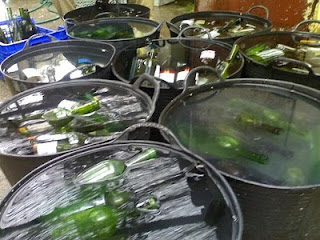The almond tree in the vineyard, and all the others in the Tajuña valley have blossomed at last. Very late in the year, this year, as usually they blossom in February round here.
Blooming Almond Blossoms
(compare with previous post)
The same almond tree
I was cutting back some grass that was too close to the vine, when I uncovered an earthwork. This is good news, as it’s a sign that our soil is healthy and full of nutrients. And even better news is that worms actively improve the fertility of the soil.
Earthworm in the vineyard
Some time back, (in this post: ___ ) I mentioned that we were going to transplant some sapling oak trees that had sprouted next to some vines, and over the weekend we moved two of them (out of a total of five that I’ve found so far).
Oak sapling's original position
Digging a hole for the sapling
Organic manure to help the sapling on its way
Planting the sapling in its new home
New Home 1
New Home 2
And lastly, here’s a pic of two little thyme plants (‘tomillo’ in Spanish) growing next to a vine. Do you think they could have any influence on the characteristics of the grapes/wine?
Little thyme plants next to a vine





































